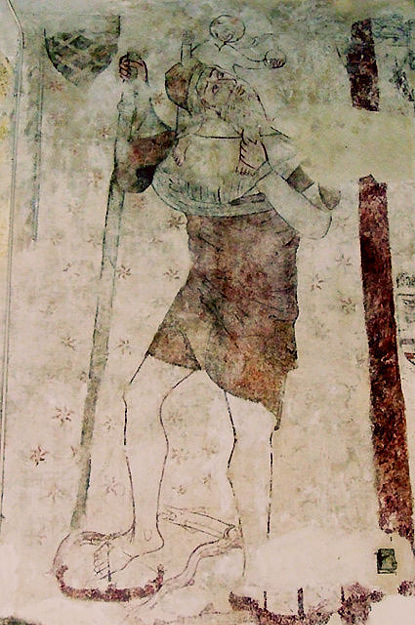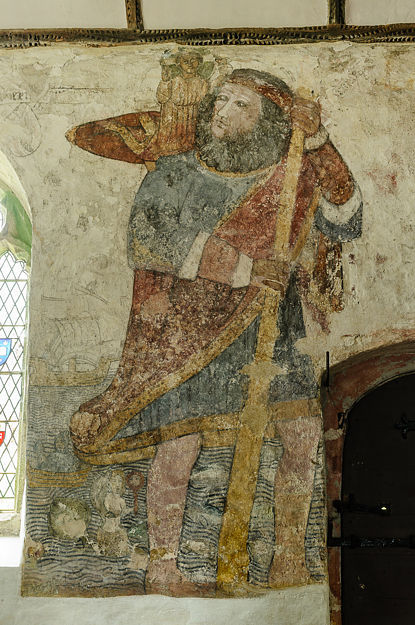St Christopher in the English Parish Church
The Most Popular Saint: A Short Introduction




St Christopher was removed from the Roman Catholic Church Calendar in 1969, and long before this the 16th century Council of Trent had tried to suppress his cult, or at least to purge it of its more fantastical elements. But Christopher’s potency as patron saint of travellers has not vanished. Medallions of the saint still sell in respectable numbers; in Britain at least, travel companies, driving schools and even filling stations are named after him.
Although his story must have been known earlier, Christopher’s popularity owes much to Jacobus de Voragine, author of the famous Legenda Aurea or Golden Legend, a compilation of legends about the Virgin Mary and various saints, along with other miscellaneous material. This went into circulation in about 1275, and in 1483 the English printer William Caxton printed his English translation, using an earlier French version of the Legend.
Long before printing, though, images of St Christopher existed in various forms and over a wide area of Europe. Carvings in stone and wood may well pre-date paintings, but there are 13th century wall paintings of the saint in England, and he was already a traditional subject in churches as far east as Bohemia by the beginning of the 14th century (and probably much earlier and farther east as well). Nor was his image confined to church interiors; at various times there have been representations of Christopher on the exterior walls of churches, as in the painting from Brione, a tiny mountain village in the Verzasca valley in Switzerland, on secular public buildings such as town halls and almost certainly on the outside walls of private dwelling houses – ‘my tenement called the Christopher’ is mentioned in at least one medieval English will. Hans Holbein’s marginal drawing, in a 1515 edition of Erasmus’s Praise of Folly shows the outer wall of what may be such a house. A passer-by, hands clasped in prayer, gazes at a painting of the Saint on a brick(?) external wall. A Latin caption drawing attention to this ‘superstitious cult of images’ accompanies the drawing.
But despite the Reformation and the attack on images, paintings of St Christopher still head the list of subjects remaining on English church walls. Generally speaking, the earliest paintings are the simplest and least detailed, showing only the Saint carrying the Christ Child, the river, with maybe a fish or two, and perhaps the Hermit with his lantern on the bank. Peripheral scenes of earlier and later incidents in the Saint’s life, along with imaginative inventions – ships, fishermen, a dolphin, even mermaids – are increasingly found in later paintings, and from the 15th century the famous woodcut of the Saint now in the John Rylands library (Manchester, England) dating from 1423 and German in origin, provided English church painters with a much followed (but often freely adapted) model. Inscriptions are sometimes found, mainly in Latin. They are usually some variant on Cristofori faciem die quacunque tueris/Illa nempe die morte mala non morieris [‘Whoever looks on the face of Christopher shall not that day die an evil death’], which is found on the John Rylands woodcut.
Affection for Christopher in the Middle Ages was not, I think, based simply on his totemic, harm-deflecting powers. His working-class or blue-collar credentials are impeccable. The equally impeccable logic of his conclusions when he observes the Devil shrinking from the Cross – ‘Thenne he is gretter and more myghtier than thou, whan thou art aferd of his signe’¹ mark him out as a man of sharp intelligence despite his lack of learning. Christopher’s Christianity is instinctive – masked by his pagan beginnings, his was a call to Christian service all along. He can no more pray or meditate – ‘I wote not what it is’² – than he can read, but the people made him a saint, and he becomes an intercessor, worthy to sit beside the Virgin Mary. And he could protect against sudden, unshriven, death – a spiritually fearful thing to a medieval mind. Small wonder, then, that he was so popular.
A Printer’s Preface: William Caxton’s Story of St Christopher, 1483 [Golden Legend]